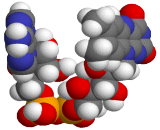Flavin Adenine Dinucleotide (FAD)

In biochemistry, FAD) is a redox cofactor involved in several important reactions in metabolism. FAD can exist in two different redox states, which it converts between by accepting or donating electrons. The molecule consists of a riboflavin moiety (vitamin B2) bound to the phosphate group of an ADP molecule. Note that the flavin group is bound to ribitol (sugar alcohol) by a carbon-nitrogen bond, not a glycosidic bond; riboflavin is thus not technically a nucleotide and the name flavin adenine dinucleotide is a misnomer. FAD is an aromatic ring system, whereas FADH2 is not. This means that FADH2 is significantly higher in energy, without the stabilization that aromatic structure provides. FADH2 is an energy carrying molecule, because if it is oxidized, it will regain aromaticity and release all the energy represented by this stabilization.
